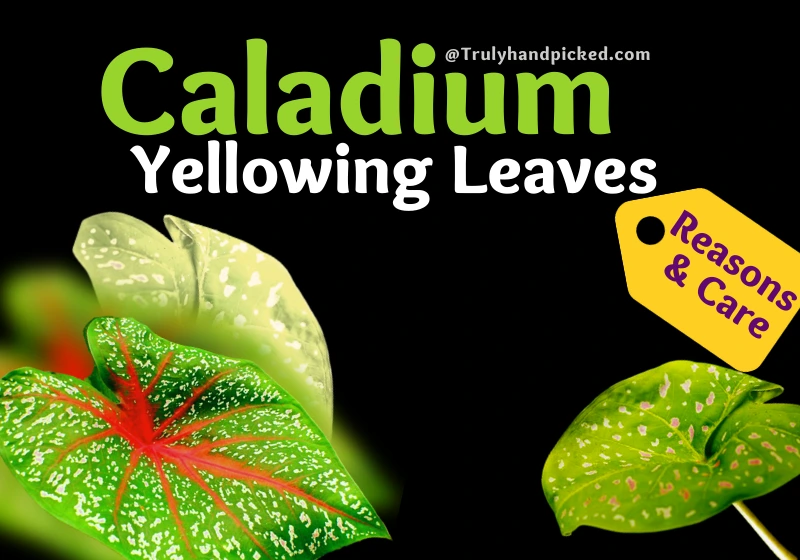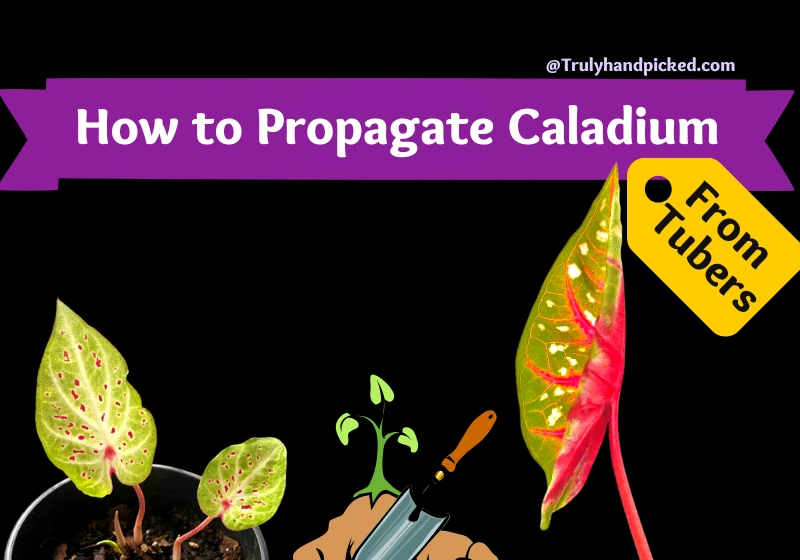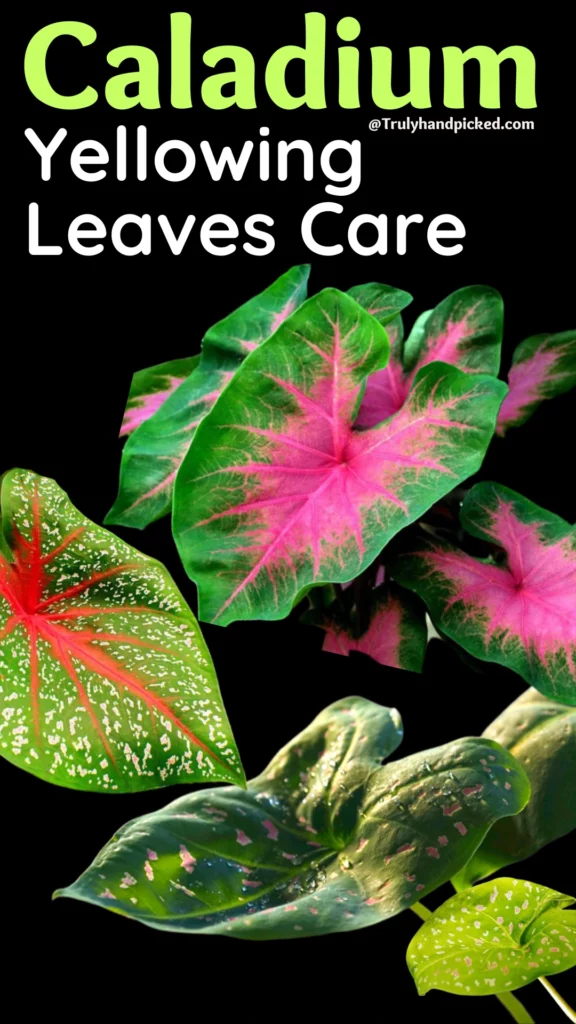Caladium is an ornamental plant that peeks spectacularly due to its vibrant and wide foliage. This plant is also known as an elephant ear or angel wings for its wide heart-shaped texture.
Yellowing Leaves in Short: Your Plant leaves could turn yellow because of nutrient deficiency, uneven watering schedule, poor drainage, and not getting enough sunlight.
While too much sun can also damage your caladiums, which show brown patches between leaves. Caladium loves morning light or shaded or dappled bright sunlight rather than a direct hit. And choose the north or eastern window for growing your caladium.
Use a potting mix that drains well, and do deep watering once a week. Also, you can spray water on leaves to create their native habitat which leaves high humidity, and also cleans your plant leaves.
Avoid tap water if loaded with chlorine and other chemicals, go for filtered in that case.
The unique shades with various bright colors on leaves, provide this flowering plant with a remarkable appearance. This species of Araceae has a very low-maintenance plant.
Caladium Plant Care- Quick Overview:
To take care of this perennial decorative plant, follow these tips attentively-
- Sow this plant in rich, well-drained, slightly acidic soil
- Put the planter in a spot with shade from the sun /partial shade/ bright dappled light or indoor bright indirect light
- Let it thrive under moderately bright but entirely indirect sunlight
- Keep the soil evenly moist by following a regular watering method
- Try to water your plant with a 1-inch deep watering once a week
- Let the soil dry a bit between watering
- Keep the temperature between 70° to 80° F with a high humidity level
- And feed your plant once a month with any slow-release fertilizer in diluted form to keep your growing caladium plant uninterruptedly healthy.
Why Are My Caladium Leaves Turing Yellow?
A growing caladium plant could have several issues due to the inadequate supply of its growing needs. Yellow leaves are one of those common issues which you may face with a growing or all-grown caladium plant. Here are some possible causes and the solutions we refer to you, in this matter-
Reasons:
- Improper drainage and soggy soil due to overwatering
- When you keep your plant dry or went underwatering
- If you keep your plant under full sun exposure or direct sunlight
- When you don’t attend some harmful pests or diseases of your plant
- Infestation of spider mites, thrips, mealybugs, etc.
- For uncured rust or blight or botrytis issues
- If your plant is having nutrient deficiency due to inadequate fertilization
- For salt buildups due to too much fertilization
- And for keeping your growing plant in a low-humid spot for a long period
Fix:
- Always use a fresh and well-drained growing medium
- Water in the correct amount and right method like once every 6-7 days, with a 1-inch depth
- Keep your plant away from direct and too much bright sunlight
- Get any possible remedy method, once you detect any kind of pest infestation on your plant
- Feed your plant once every 2-3 weeks with half of the strength liquid fertilizer but not more than this schedule
- Keep the humidity level of the place high, where you put your planter or grow your caladium plant permanently
- And never let the root water-logged in any circumstance
How to Propagate Caladium:
Caladium plants are tubular and thus, easy to propagate through tubers than other ways of regrowing. Here we come up with the easiest way of caladium propagation in this attempt-
Propagation with Tubers:
- Let the leaves dry in fall and the soil soaked completely
- After that, drag out the entire plant from its current planter and store it in a box
- Keep the box in a moderately warm spot for the whole winter season
- Once the winter is passed, take out the plant and cut the tuber out
- Use a sterilized cutter to trim and make sure that each tuber has a growing section
- Keep the newly trimmed tubers open for a week to heal naturally
- Then bring a new pot with fresh potting soil
- Sow the tubers in new pots by keeping the eye part facing up in the soil properly
- Water it and place it in a high-humid warm spot to thrive naturally
Everything About Yellowing Leaves of Caladium Plant
Q: Why are my caladium leaves turning yellow?
A: Caladium leaves can turn yellow for several reasons, including overwatering, underwatering, insufficient light, pests or diseases, or natural aging.
Q: How do I know if my caladium is overwatered or underwatered?
A: Overwatered caladiums may have yellowing leaves that are soft and mushy, while underwatered caladiums may have yellowing leaves that are dry and crisp.
Q: How can I prevent the yellowing of caladium leaves?
A: To prevent the yellowing of caladium leaves, ensure that the plant is receiving appropriate water, light, and nutrients. Allow the soil to dry out slightly between waterings and avoid exposing the plant to direct sunlight or excessively cold temperatures.
Q: What should I do if my caladium leaves are turning yellow?
A: If your caladium leaves are turning yellow, first assess the possible causes, such as overwatering, underwatering, or pests. Adjust the watering schedule and check for pests. Prune away any yellowed leaves to promote new growth.
Q: Can yellowed caladium leaves turn green again?
A: No, yellowed caladium leaves cannot turn green again. Prune away the yellowed leaves to promote new growth.
Q: How often should I water my caladium plant?
A: Caladiums prefer consistently moist soil, but not waterlogged. Water when the top inch of soil is dry to the touch.
Q: How can I improve the overall health of my caladium plant?
A: To improve the overall health of your caladium plant, ensure that it is planted in well-draining soil, receives adequate sunlight and water, and is fertilized regularly during the growing season. Also, ensure that the plant is not exposed to extreme temperatures or drafts.
Recap: Yellowing Leaves – Caladium Plant Care
Adjust watering schedule:
Check the soil moisture level by sticking your finger into the soil up to your second knuckle.
Water the plant only when the top inch of soil feels dry to the touch.
Do not let the soil become waterlogged, as this can lead to root rot.
Ensuring proper drainage:
Make sure the pot has drainage holes at the bottom.
Use well-draining soil.
Avoid letting water sit in the saucer beneath the pot.
Make Changes to Sunlight exposure:
Caladiums prefer bright, indirect light.
Avoid exposing them to direct sunlight, as this can scorch the leaves.
Move the plant to a shadier location if it is getting too much sun.
Fertilize on time:
Caladiums require balanced fertilizers with equal amounts of nitrogen, phosphorus, and potassium.
Fertilize the plant once every two weeks during the growing season (spring and summer).
Use a water-soluble fertilizer and follow the manufacturer’s instructions.
Treat pests or diseases:
If you suspect pests or diseases, identify the problem and use appropriate treatment methods.
For example, neem oil can be used to treat spider mites and scale insects, while copper fungicides can be used to treat fungal diseases.
Remove any affected leaves or stems and dispose of them in the trash.
Caladium Plant’s Lighting Needs
Q: How much sunlight does a Caladium plant need?
A: Caladium plants require bright but indirect sunlight to thrive. Direct sunlight can burn their leaves and cause them to wilt. Ideally, they should be placed in a location with bright, filtered light or partial shade.
Q: Can Caladium plants grow in low light?
A: Caladium plants can tolerate low light conditions, but they will not thrive in such an environment. Without sufficient light, the leaves may become smaller and the plant may not produce as many leaves or reach its full potential size.
Q: Can Caladium plants grow in full sun?
A: While Caladium plants can tolerate some direct sunlight, full sun can be harmful to them. Direct sunlight can cause their leaves to wilt, scorch or burn, and may even kill the plant.
Q: How can I protect my Caladium plant from too much sunlight?
A: To protect your Caladium plant from too much sunlight, you can place it in a location with bright but filtered light, such as near a window with a sheer curtain or under a tree canopy. You can also move it to a location with more shade if you notice its leaves beginning to wilt or burn.
Q: What is the best time of day to expose Caladium plants to sunlight?
A: The best time to expose Caladium plants to sunlight is in the early morning or late afternoon when the sun is less intense. Avoid exposing them to direct sunlight during the middle of the day when the sun is at its strongest.
Q: Can Caladium plants be grown indoors?
A: Yes, Caladium plants can be grown indoors as long as they are placed in a location with bright, filtered light. They can also be grown outdoors in containers or in shaded garden beds.


